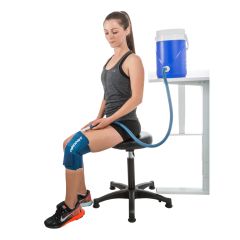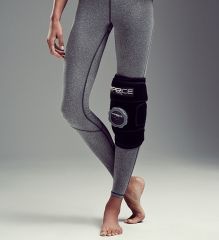Knee Pain and Swelling
Knee pain is one of the most common forms of joint pain (if not the most common) in the human body. And one of the symptoms associated frequently with knee pain is swelling. Swelling in the knee makes the joint appear puffy and it may be uncomfortable. Fluid from areas around the knee - in some cases this fluid may be blood - can fill the joint and thus cause swelling in back of knee or in the front of the knee. In this article you will learn more about knee swelling and pain.
Where can knee swelling occur?
Swelling can occur all over the knee, but sometimes it is in a specific area. Here are the most common:
- Swelling behind knee (or back knee swelling)
- Swelling below knee cap (lower knee swelling)
- Upper knee swelling (swelling above knee cap)
Of these, the most common is behind the knee swelling followed by swelling around the knee cap.
What causes knee swelling?
Any type of knee injury or chronic knee condition may cause knee pain and swelling. The presence of swelling, how fast an area swells, and location of the swelling combined with your medical history may help indicate the type of injury that has occurred. If you suspect your knee has an issue, consult your doctor to determine the cause of the knee swelling and pain.
If you recently had an injury to your knee due to some sort of trauma (such as a sports injury or a fall) and the knee is swelling quickly and all over the joint, then it is likely you have torn a ligament or the cartilage (meniscus) in the knee.
If you recently had an injury to your knee due to trauma and the knee is swelling slowly, then it is also likely a meniscus or ligament injury. In the case of delayed swelling, the inner part of the meniscus may be torn and the ligament is usually sprained (overstretched), but not torn.
Typically for injuries with knee pain and swelling, the swelling is all over the knee and not in a specific location, such as behind the knee swelling. However, in some cases the knee swelling may be more toward one side or another of the knee.
If you have not had an injury and have rapid knee swelling, then it is likely infection or gout. If you have not had an injury and there is slow knee welling, it is likely arthritis or another type of chronic condition.
Swelling behind the knee (also known as popliteal bursitis) is most often a Baker's cyst, is when the fluid sac behind the knee is inflamed. Swelling behind knees from a Baker's cyst can occur as a side effect of an injury.
Other causes for swelling around the knee can be from conditions such as gout and bursitis.
Management of Knee Swelling and Pain
Options for knee swelling vary depending on the cause of the condition. If you are experiencing knee pain and swelling, consult your physician for the appropriate form of treatment.
Typical courses of action for knee swelling consists of the following:
In the case of injury or trauma to the knee, the go-to first aid approach is the RICE method of 1) Rest 2) Ice 3) Compression and 4) Elevation. Your doctor will then likely evaluate the knee using an imaging process such as an X-ray and/or MRI to determine if you have sprained or torn ligaments or cartilage.
Ice or other forms of cold therapy are also used to reduce swelling in the knee. Cold therapy, also known as cryotherapy, helps reduce the pain and swelling. For inflammation your doctor may also recommend over-the-counter pain medications such as aspirin or ibuprofen.
Your doctor may also aspirate the knee, which means a needle will be inserted where there is swelling of the knee, and the fluid causing the swelling (usually blood), will be removed from the area. This can reduce pressure and provide knee pain and swelling relief.
For chronic, lingering forms of knee swelling, wearing a knee brace may help support the knee and minimize the strain on the joint. This is especially helpful for those suffering from forms of arthritis, as a knee brace may move pressure away from worn down areas of the knee to healthier parts of the knee. The reduced strain often helps minimize knee smelling in the joint.
Again, speak with your doctor to determine the best form(s) of treatment for your knee swelling and pain. He or she will work with you to decide on the appropriate forms of treatment for your situation.






